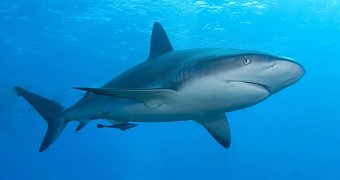Just a drop of blood and the place is infested with sharks: these fishes are famous for their keen sense of smell. But a new investigation made by Boston University marine biologists reveals that sharks use not only their nose in detecting the smell of their prey; they also use their skin, more precisely their lateral line.
The lateral line is employed by all fish to accurately track down movement and vibration in the surrounding water, almost the same way humans can feel air flow with the small hairs on the face. This is the first time the lateral line was also found to locate odor plumes.
"Odor plumes are complex, dynamic, three-dimensional structures used by many animal species to locate food, mates, and home sites. However, odor itself has no directional properties, so animals must use a variety of senses to get the directional information for a smell," said coauthor Jelle Atema, professor of biology at Boston University.
The research made on the smooth dogfish shark revealed that this species cannot locate the source of an odor when its lateral line is blocked, especially in the dark.
"Since most odor plumes disperse in patches, fish locate odor sources through a process referred to as "eddy chemotaxis," or the tracking of odor and turbulence simultaneously. We might see odor and turbulent eddies in the oily wake behind a boat. A moving animal, similarly, leaves behind a trail of turbulent eddies flavored by its body odor," explained Atema.
The researchers made two parallel, turbulent eight meter odor plumes in the lab making use of squid scent and a plain seawater control.
The small turbulent 'oozing' sources of squid odor and seawater control were separated from sources of major turbulence by putting a brick downstream from each oozing source to trigger two turbulent wakes with one or the other flavored with food odor, resulting four separate smell targets for the sharks to track down.
"In addition, we also tested the sharks under two light conditions - fluorescent and infrared - and in two sensory conditions - with their lateral lines intact or lesioned by streptomycin," explained Gardiner.
Streptomycin is an antibiotic that impairs the normal function of motion sensitive hair-like receptor cells of the lateral line.
In humans too, high amounts of this antibiotic induce hearing and equilibrium problems, as these receptors are also hair-like cells.
Sharks with intact lateral lines clearly displayed a preference for the odor plume instead of the seawater plume and especially for the odor source with the higher turbulence (the brick on the odor side) than the odor alone (the odor-oozing nozzle). Plume, target preference and search time were not influenced by lightness, but with the impaired lateral line, sharks increased search time, with the same success rate or plume.
But blocking the lateral line made the animals no longer make the difference between sources of turbulent and oozing odor. In dark conditions, search time of sharks with a blocked lateral line increased even more, and the few individuals that located a target did not make the difference between odor and seawater plumes, let alone targets.
"These results demonstrate for the first time that sharks require both olfactory and lateral line input for efficient and precise tracking of odor-flavored wakes and that visual input can improve food-finding when lateral line information is not available," said Atema.
"Since dogfish feed primarily in the dark hunting for crabs, lobsters, shrimp and small fish, their reliance on information from their lateral line is essential. The results are interesting for our understanding of animal navigation under water and for the development of guidance of autonomous underwater vehicles (AUVs)"

 14 DAY TRIAL //
14 DAY TRIAL //